
by Regan Bervar | Sep 27, 2021 | Main Articles
“Space has the ability to produce a triple bottom line, or ROIII: Return on investment, innovation, and inspiration.” — Robert C. Jacobson
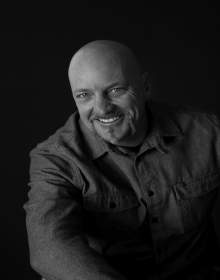 by Luke Schmaltz
by Luke Schmaltz
If you ask most Colorado residents to name the top attractions that define their state, you’ll hear things like professional sports, recreational and medical cannabis, and year-round outdoor recreation and adventure. Yet, most folks may be unaware that, according to the Colorado Office of Economic Development and Economic Trade (choosecolorado.com), the Centennial State holds the top ranking in private aerospace employment concentration and is host to the nation’s second largest aerospace economy.

High Speed Flight: Boom Supersonic aims to use ultra-high-speed flight to get travelers to their destinations in under half the normal time.
A July 29, 2021, article in The Denver Post announced the addition of yet another aerospace company to the local roster — PteroDynamics — a California-based company that will soon be headquartered in Colorado Springs. The piece quotes Governor Jared Polis as saying, “Colorado continues to be the leader in aerospace and defense industries, so this new announcement and the 186 good news jobs that come with it further strengthens our reputation as the nation’s best place for aerospace.” Additionally, according to a 2020 report by the Metro Denver Economic Development Corporation, Colorado is home to 290 aerospace tech companies employing a total of 33,460 employees with over 500 organizations specializing in aerospace products and services. Over the past five years, aerospace employment has grown over 30% in Colorado — placing the state 12% higher than the national average.
The industrial roll call is impressive and diverse. The list of companies runs the gamut in terms of size and configuration — comprising a variety of private sector startups, medium-sized companies, and large corporations with household name recognition. While this is far and away from a comprehensive list, here is a brief sampling of the sort of incredible innovation and forward-thinking commerce taking place in your own backyard.
Boom Supersonic
According to Founder and CEO Blake Scholl, the Denver-based company was built on a philosophy of “Speed, safety, and sustainability without compromise,” as explained in a company promotional video. “We’ve made incredible advancements in the foundational technology for designing, developing, and building aircraft,” Scholl continues. “We have advanced aerodynamics, new materials, and significantly more efficient engines.” The company boasts the XB-1, the industry’s first-ever independently developed supersonic jet. Which has served, through trial, error, and improvements upon both to inform every aspect of the company’s passenger airliner, Overture. Boom Supersonic designed this commercial jet to serve travelers with flight times twice as fast as current commercial airlines.
Atomos Space

Missile Launch Technology: Boecore specializes in early warning missile launch technology, among other things.
Dedicated to meeting and exceeding the satellite-launching needs of the telecommunications industry, this award-winning Denver-based company is currently under contract with NASA. Their philosophy is to end the launching of single-use rockets to launch satellites into space. In a company website video, Co-Founder and CEO Vanessa Clark equates the current practice to “flying passengers one at a time in a Boeing 747.” She explains, “At Atomos, we are building and operating space tugs — transportation vehicles that are the connecting flights for space. Rockets no longer need to go to the specific orbit for a specific satellite. With space tugs, rockets can launch all satellites to a single drop off point, and we’ll take them from there.” Essentially, Atomos is the world’s first satellite rideshare company. The benefits are threefold: decreased cost to get into space, increased number of satellites per launch, and reduced wait times for a scheduled launch.
Boecore
This Colorado Springs-based aerospace and defense engineering company is women-owned and operated and maintains a small business status with fewer than 200 employees and a personnel-centric company culture. Their website states that they specialize “in software solutions, systems engineering, cybersecurity, enterprise networks, and mission operations.” With a client base consisting mainly of government agencies, Boecore boasts a highly respected company reputation as well as an impressive array of industry awards, including the 2020 Pro Patria Award for Extraordinary Employer Support, Entrepreneur of the Year Award, and Best Workplaces in Colorado Springs — among many others. Company innovations include early warning missile launch technology, space operations software solutions, Battlespace Operational Readiness Game (BORG) training modules, and many others.
York Space
This Denver-based company operates a “mega-facility” for commercial manufacture of satellites for companies who want to operate satellites in orbit. A news blog released earlier this year on the company website announced the recent expansion of its headquarters into a 100,000 square-foot facility. Company CEO Dirk Wallinger recently told CNBC the expansion adds “a true robust production capability to help secure our supply chain and help us expand the contracts that we’re working on with existing customers.” He went on to explain that the upgrade will take the company’s current manufacturing of 1,000 spacecraft per year and, “blow that out of the water as far as total production capacity goes.” York’s business model leverages a proprietary design known as the S-CLASS platform. The design is based on a three-axis stabilized spacecraft intended for constellations and designed for mass production. Buyers can use the modules for a variety of missions such as weather monitoring, communication, and observation.
The list goes on and on — including recognizable monikers such as Lockheed Martin, EnerSys, Merrick & Company, Ball Aerospace and Technologies Corporation, Ascent Solar, and many more.
It Begs The Question
With all these engineering geniuses in proximity, it is utterly baffling that Colorado — specifically the Front Range and the Western Slope I-70 corridor — are facing widespread engineering mishaps and systematic infrastructure breakdown. You would think that the elected leaders, with immediate access to such innovation and solution-oriented implementation, would reach out and ask for a bit of advice from folks who truly know how to solve problems. It is possible, however, that most of these aerospace firms have blocked incoming calls from government phone numbers. Or perhaps they are all simply too smart to get involved with politicians and bureaucrats. Or maybe — just maybe — given Colorado’s elevation and relative proximity to the stratosphere, they are all working in unison to find the quickest way off this troubled planet, if only for a little while.
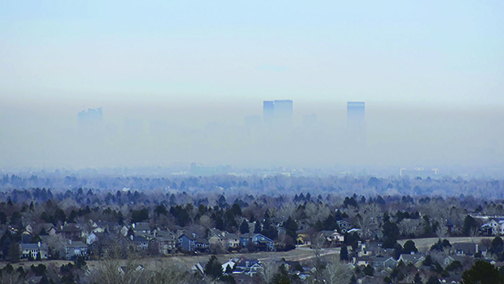
by Regan Bervar | Sep 27, 2021 | Main Articles
“We didn’t start the fire/It was always burning, since the world’s been turning.” Billy Joel
 by Luke Schmaltz
by Luke Schmaltz
The brown cloud which frequently blankets the Mile High City has long been recognized as an unfortunate byproduct of progress. Since the 1980s, locally produced carbon emissions from coal-based energy production, oil refinement and the automotive combustion of gasoline has created a problematic airborne miasma. In the last few years, Denver has been given distinction among the top 10 cities with the poorest air quality in the United States. Federal records show air pollution was at elevated levels for more than 260 days a year in 2019 and 2020.
Meanwhile out West, the Golden State is leading the way in the creation of a different type of pollution, wildfire smoke. Just as California exports entertainment, social trends, and hordes of transplants, it also sends a generous share of air particulates from incinerated vegetation to round out its contribution to Colorado. A place that, as anyone who lives here knows, is already dealing with its own wildfire crises.

At times, the brown cloud over Denver can, in part, be attributed to the California wildfires.
Paper Is Made From Wood
To understand the proliferation of pollution, all you have to do is follow the money. America’s addiction to coal-based energy and oil-based propulsion has stakeholders running the ship aground who are perched in plain sight. The same is true with wildfire-based pollution. The logging industrial complex, which is particularly busy in some parts of California, is making a mint while communities are being destroyed, lives are being lost, and Colorado is choking on the ashes.
So far this year, Cal Fire (fire.ca.gov/inci dents) reports 7,377 fire incidents which have killed three people, destroyed 3,285 structures, and burned 2,243,663 acres of forest. The latter statistic is of particular interest here, as the massive plumes of smoke are systematically swept up by jet streams, carried inland, and deposited at the eastern base of the Rocky Mountains.
A Climate-Driven Performance Enhancer
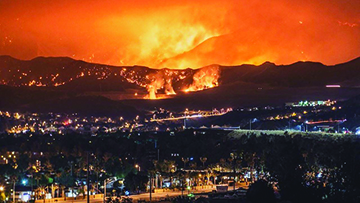
Lucy Walker’s film “Bring Your Own Brigade” tells the story of how concentrated fuel sources are creating fires that can’t be stopped.
Clearly, this phenomenon is ramping up in tandem with global warming. Unnaturally dry conditions can turn large expanses of forest into an incendiary event waiting to turn the tiniest spark into a nightmare inferno. Some of these blazes occur in clear-cut areas which have been recently “thinned” by logging operations both private and government-operated. For decades, the United States Forest Service (USFS) has conducted these “thinning” initiatives under the guise of “fire prevention” but the data overwhelmingly demonstrates that wildfires tend to spread faster and with much more intensity in clear-cut areas due to dry conditions and contiguous acres of branches and logs which were left over from the logging process. Recent examples include the Dixie Fire which incinerated large parts of the Sierra Nevada town of Greenville and the Caldor Fire which destroyed the entire town of Grizzly Flats, CA.
Chad Hanson is an Author and ecologist with the John Muir Project. He recently published Smokescreen: Debunking Wildfire Myths to Save Our Forests and Our Planet.

Author Chad Hanson blows the California wildfire story wide open in his new book, Smokescreen.
Hanson is an expert in the phenomenon and the region, having conducted fieldwork for his doctoral dissertation in the aforementioned Greenville. In a recent article published on Grist.org, he explains, “The primary focus of the agency’s forest management efforts is selling public trees to private logging companies, which generates about $150 million each year. That may sound like a small portion of its $2 billion budget for land management, but logging also brings in more than $1 billion in annual Congressional appropriated funds, which generate additional revenue that goes back into the agency’s budget.” In a clever pivot, the USFS recently stopped using descriptive terms like logging and timber harvest and instead began conducting the same activities under the banners of terms like forest health, ecological restoration, and fuel reduction. But, as Hanson points out, “Make no mistake. It’s all just logging.”
Rural Overpopulation
There is another dimension of the fire industrial complex at work in California, but it stems from an opposing set of dynamics. Commercial land which has been clear cut is being replanted with dense concentrations of trees slated for harvest as soon as they have matured to a certain height and width. The problem here is that thick concentrations of trees, especially those reduced to drought-choked rows of veritable matchsticks, create an overly-abundant fuel source — one which burns with unstoppable ferocity.
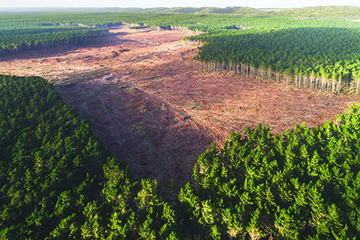
Contrary to popular opinion, clear cutting large sections of forest contributes to the wildfire phenomenon.
Lucy Walker is an Oscar-nominated director whose recent release “Bring Your Own Brigade” is once again heating up the wildfire debate. The film was shot in 2018 during the Thomas Fire in Ventura and Santa Barbara Counties, CA. While the piece makes a strong case for the need to reverse climate change, it also documents how efforts from the USFS and private corporations have created dense forests where a sparse topography once existed — setting the stage for heat- and drought-driven wildfires to thrive. “Comparing photographs makes it very clear,” she explains in the narration. “You can see the changes [through time] and you can see what ‘fire suppression’ has done. Forests just didn’t used to be this thick.” An unnamed resident interviewee confirms this, explaining, “In the past it was more of a savannah situation. Bigger trees spaced farther apart. Now, you’ve created a heat source you can’t stop.”
Professor Pyro
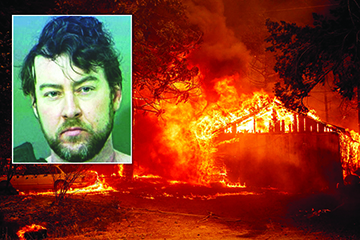
Gary Stephen Maynard, a Criminology professor and holder of a doctorate in Sociology, is accused of lighting forest fires in California.
Gary Maynard is a tenured academic of the California Collegiate system, teaching — quite ironically — criminal justice. The esteemed professor has, until recently, been an enthusiastic contributor to the Golden State’s greatest airborne export. In July and August of 2021, he allegedly went on an unprecedented spree of arson and wholesale destruction. He was recently accused of having set a series of half a dozen fires in the Lassen and Shasta Trinity National Forest areas. These blazes, according to agents from the USFS, were designed to trap authorities and firefighter crews.
Maynard also holds a doctorate in sociology from Stony Brook University in Brookhaven, New York, as well as two additional master’s degrees. Pinpointing his motives will no doubt be a challenge, and reports of court proceedings offer little insight into his mindset — other than repeated denials and blue streaks of profanity aimed at police officers. Whether this is an isolated incident and Maynard is an anomaly, or he is part of a bigger scheme to create anarchy is undetermined. Yet, given the climate of general mania which seems to have much of the general populace in its grip, the idea of a cabal of arsonists creeping about the California woods with a penchant for pyromania is not exactly farfetched.
While California wildfires are certainly not the main culprit of poor air quality in Denver, they are a definite contributor. Hanson and Walker have demonstrated the cause of some of these catastrophes while Maynard has shown how easy they are to ignite. While not wholly unavoidable, wildfires could be reduced were it not for the almighty dollar. This paper byproduct of trees seems to skew the logic of even the most perceptive of people. In this case, it is especially true for those with large government contracts worth many millions of dollars and not a damn to give about who chokes on what, where or when.
by Mark Smiley | Sep 27, 2021 | Main Articles
by Jessica Hughes
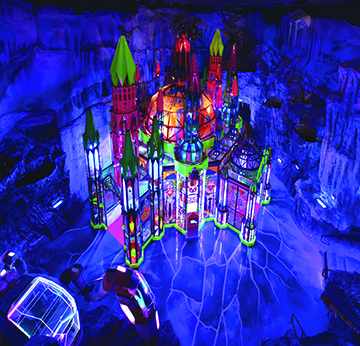
The towering castle of Ice World. Photo by Kennedy Cottrell | Courtesy of Meow Wolf
After four years in the making, Denver celebrated the grand opening of the highly anticipated Meow Wolf last month, finally making its way from fantasy to reality. As the company’s largest permanent installation, the immersive exhibit will showcase the work of over 300 artists, including 110 Denver artists within four stories of a 90,000 square-foot structure. Alongside the installations, the venue also hosts a large 450-person music venue and a 2,000 square-foot retail space and café.
The installation is called Convergence Station, where a mystical narrative follows the art on display through an immersive experience. According to the press release, “It is the first stop on a quantum journey of exploration and discovery as passengers traverse new worlds, and like all Meow Wolf locations, labyrinthine mysteries beckon from its vibrant walls, portals, and wormholes. Twenty-five years ago, a freak cosmic event merged four worlds from different universes, erasing the memories of all residents and spawning the mystifying disappearances of four women.”

The other world of CataCombs. Photo by Kennedy Cottrell | Courtesy of Meow Wolf
Visitors will be transported through different worlds including kaleidoscopic cathedrals, Corinthian catacombs, lush alien habitats, and dazzling and gritty cityscapes. In this hotbed of interplanetary cohabitation, memories serve as both currency and the key to unlocking the story behind the women’s disappearances and cause of the convergence — as do multimedia clues that reveal themselves to all the senses.
Muralists, sculptors, fiber artists, and technologists have come together to create a one-of-a-kind installation, including notable artists Kalyn Heffernan, Christopher Nelson, Everything is Terrible!, Molina Speaks, Sofie Birkin, along with Moment Factory and many others.
The venue is located at 1338 1st St., Denver, CO 80204, and is nestled in the middle of W. Colfax Ave. and I-25, in the heart of the Sun Valley neighborhood. Those passing by will recognize the stand-alone building, with its pizza-like shape, florescent lighting, and four floors of interactive exhibits interconnected through vertical travel and secret passageways.
“Denver’s art scene is active and vibrant, making it the perfect place for our next exhibition,” said Chadney Everett, Executive Creative Director of Meow Wolf Denver. “Convergence Station is Meow Wolf’s third permanent immersive experience, and it will truly change the way you look at art. This exhibition is unlike anything you’ve ever seen…from The Swamp to The Cathedral — there’s a strong narrative to be uncovered should you choose, alongside truly mind-bending art from the many talented creatives that have worked so hard to bring the vision to life. We can’t wait for everyone to explore.”

The Sa Lawn exhibit at Meow Wolf’s new Convergence Station in Denver. Photo by Kennedy Cottrell | Courtesy of Meow Wolf
Meow Wolf is a Santa Fe-based arts and entertainment company that creates immersive, interactive experiences to transport audiences of all ages into fantastic realms of story and exploration. The company’s first location in Santa Fe opened in 2016, showcasing the House of Eternal Return.
Then in 2019, Meow Wolf expanded beyond Santa Fe and opened Kaleidoscape, the world’s first artist-driven ride at Elitch Gardens in Denver. Meow Wolf recently opened their second permanent installation, Omega Mart, at AREA15 in Las Vegas, and the third permanent installation is now in Denver.
Meow Wolf is now open from 10 a.m. until 10 p.m., Sunday through Thursday and from 10 a.m. until 12 a.m. on Fridays and Saturdays. Hours are subject to change.
Tickets are available for pre-purchase for $45 for General Admission ($40 Children / Seniors / Military), and $35 for Colorado Residents. Visitors are required to pre-book a time slot for entry.

by Glendale Sports Center | Sep 27, 2021 | Glendale City News
by Cate Plekon, Lifestyle Medicine Manager, YMCA of Metro Denver
You can tell a friend about losing your hair or chemo, but if you haven’t been through it, it’s hard to understand. For Sandra, the Livestrong program gave her the chance to be with and talk to people who could relate to what she was going through. In Sandra’s case it was lymphoma.
Today Sandra is doing well and, in talking about her experience, says “I didn’t want the program to end. It made me exercise!”
In partnership with the Livestrong Foundation, the YMCA Livestrong program helps cancer survivors return to health after treatment. The 12-week program is offered at no cost to participants who have been diagnosed with cancer. Improving physical strength and endurance is our goal, but mental and emotional support is equally important. You do not have to be a member of the YMCA to be part of the program, but if you are not, you get a complimentary family membership for the duration of your time in the program. An extra incentive!
For Dave, a participant who underwent four cycles of chemo and 35 high doses of radiation, he needed guided support. “The impact of the program has been tremendous.”
We believe in total wellness at the YMCA. Through the Livestrong program, we meet participants exactly where they are. The program is open to any cancer survivor — you may be recently diagnosed, undergoing treatment, preparing for surgery, or a year into remission. We can help.
This is the fifth year of our program, and we are proud to have helped more than 100 participants through the program. While COVID-19 sidetracked in-person interaction in 2020, sessions continued virtually for those who were able to join. 2021 sessions restarted this month at the University Hills and Littleton YMCAs.
If you or someone you know wants to learn more about the Livestrong program at the YMCA, visit www.denverymca.org or contact us at communityhealth@denverymca.org.













